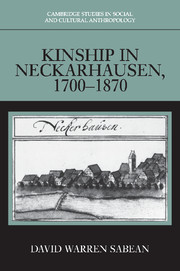Book contents
- Frontmatter
- Contents
- List of tables
- Abbreviations
- Abbreviations of sources
- On reading kinship diagrams
- Glossary
- Preface
- Introduction
- Cohort I (1700–1709)
- Cohort II (1740–1749)
- Cohort III (1780–1789)
- Cohort IV (1820–1829)
- Cohort V (1860–1869)
- Conclusion
- 20 Neckarhausen in European comparative perspective
- 21 Consanguinity in modern Europe
- 22 Kinship and class formation
- 23 Kinship and gender
- Appendix
- Bibliography
- General index
- Index of villagers
21 - Consanguinity in modern Europe
Published online by Cambridge University Press: 04 August 2010
- Frontmatter
- Contents
- List of tables
- Abbreviations
- Abbreviations of sources
- On reading kinship diagrams
- Glossary
- Preface
- Introduction
- Cohort I (1700–1709)
- Cohort II (1740–1749)
- Cohort III (1780–1789)
- Cohort IV (1820–1829)
- Cohort V (1860–1869)
- Conclusion
- 20 Neckarhausen in European comparative perspective
- 21 Consanguinity in modern Europe
- 22 Kinship and class formation
- 23 Kinship and gender
- Appendix
- Bibliography
- General index
- Index of villagers
Summary
Although various disciplines have been concerned with kinship in Europe, none has yet considered how the region's diverse aspects of familial reciprocity have connected with one another over time. Some biographers and social historians have discussed the manner in which particular industrialists or groups of workers utilized kin, but few writers have examined the phenomenon systematically, let alone comparatively or conceptually. Of the work that has been done, more has focused on marriage than any other aspect of kinship, no doubt because since the mid nineteenth century biologists and geneticists have been interested in the physical and mental effects of consanguineal marriages on descendants. But their interests have been confined to people who demonstrably share the same “blood” or genetic makeup – those who descend from a common ancestor. For these scientists, other conceptions of incest can get in the way of their investigations. Thus a series of dispensations that failed to distinguish between marriage with a cousin and marriage with the wife's sister would fail to offer the kind of information they need. In many studies of endogamy based on easily accessible records of dispensation, just such problems arise: the rate can be skewed by the fact that an unknown percentage of couples avoided applying for dispensations, or officials might have left gaps in their records; various categories have often been handled indiscriminately (first and second cousins, cousins and sisters-in-law, relatives by blood or marriage and godkin); and reckoning of relationships might be haphazard or fail to follow prescribed rules.
- Type
- Chapter
- Information
- Kinship in Neckarhausen, 1700–1870 , pp. 428 - 448Publisher: Cambridge University PressPrint publication year: 1997



